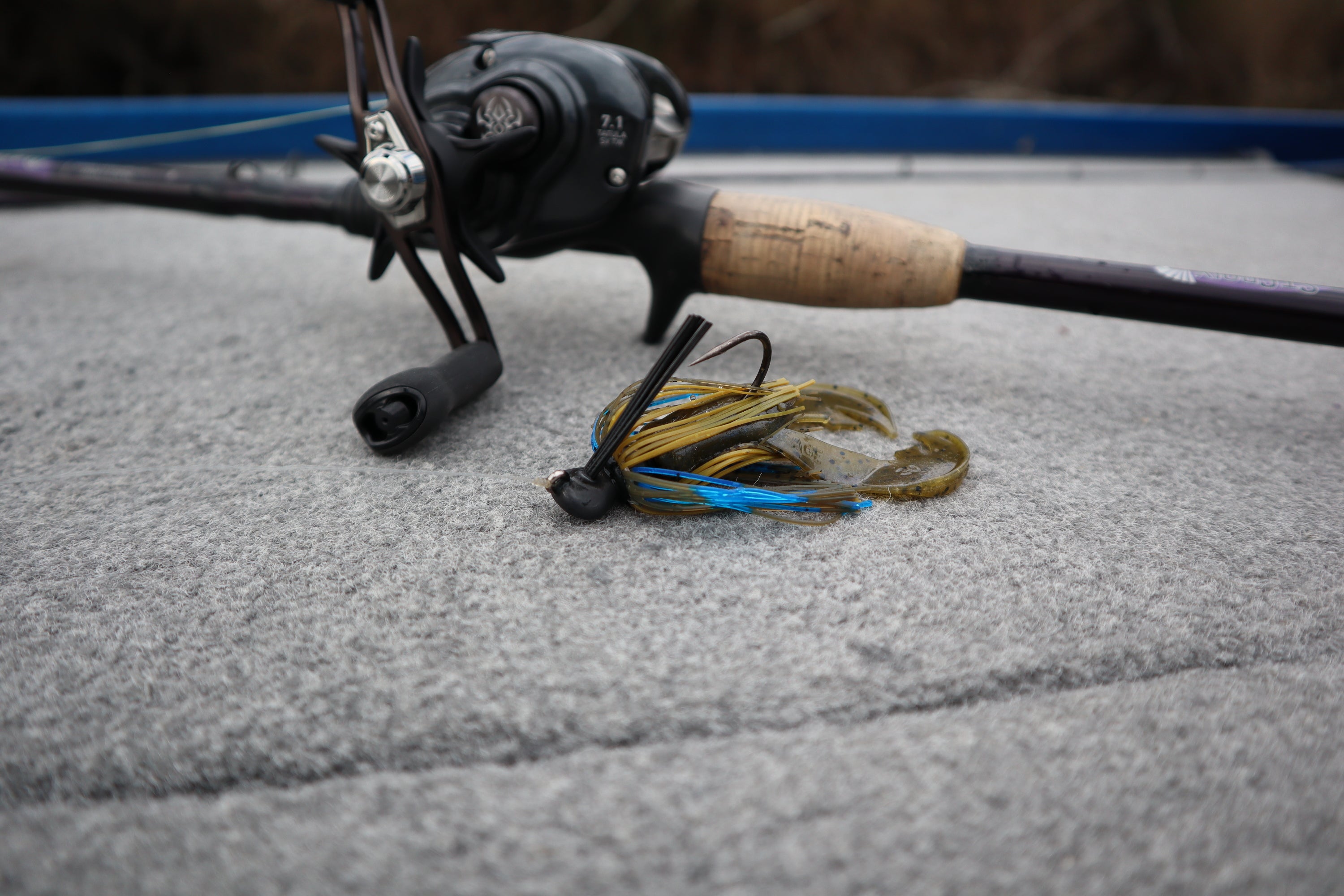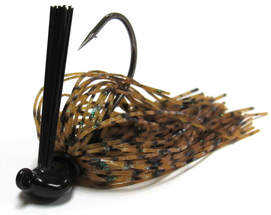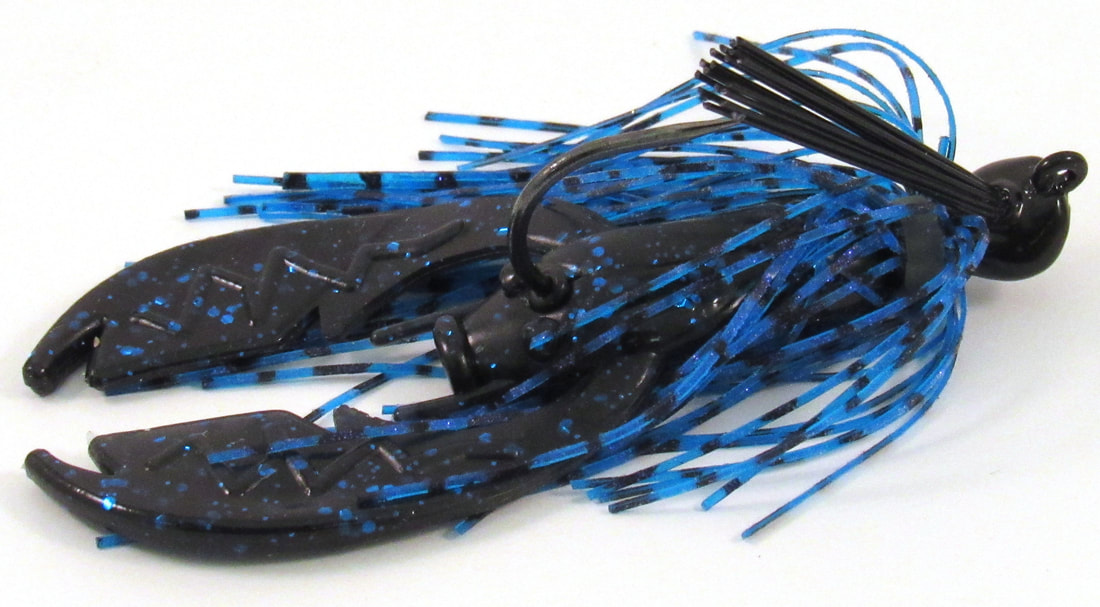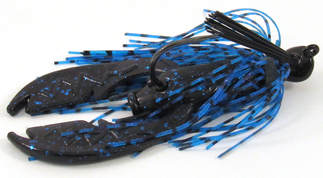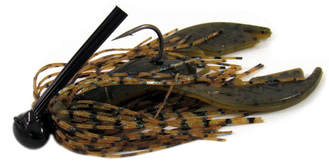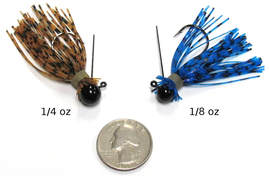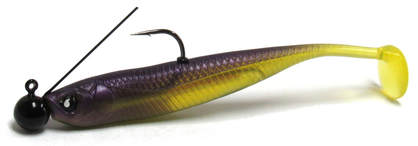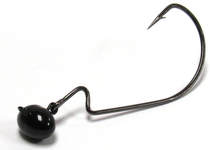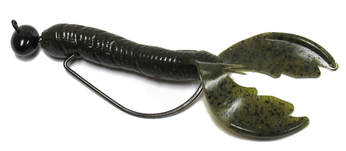Jigs are an extremely popular lure for bass fishing, and they receive a lot of attention from tournament and professional bass anglers as a bait that is capable of catching larger bass on average than many other lures.
|
There are several styles of jigs, each with their own special purchase. While some jigs can overlap to perform the duties of other jigs, each one is designed with characteristics that make it best at its designated task.
Flipping Jigs: Flipping Jigs (or “flippin jigs”) are designed to be fished in dense cover, whether it's grass, weeds, submerged timber, laydown trees, under docks, or anywhere else where most other lures would get snagged. These jigs are usually fished with a craw or creature trailer, with the intent of mimicking a crawfish or other bottom dwelling creature. Flipping jigs are often fished on baitcast rods/reels, as they can be casted, flipped, or pitched quickly with this setup. However, beginners can fish flipping jigs on beefier spinning equipment until confident in his/her abilities with a baitcaster. They can be fished with braid or flouro/mono line, depending on water clarity and thickness of cover. In brief, flipping jigs are fished by casting, flipping, or pitching the jig into the area of heavy cover, allowing the jig to sink until it reaches the bottom, and then slowly crawling or hopping the jig during the retrieve. The angler can pause and allow the jig to sit still for any length of time during the retrieve as well.
3/8oz and 1/2oz flipping jigs are excellent for water less than 10' deep. 3/4oz or larger jigs are great for deeper water, as the jig can reach the bottom quicker. However, in cold water, bass may not be willing to chase a fast sinking jig, so lighter jigs can be used even in deep water during cold water periods.
3/8oz and 1/2oz flipping jigs are excellent for water less than 10' deep. 3/4oz or larger jigs are great for deeper water, as the jig can reach the bottom quicker. However, in cold water, bass may not be willing to chase a fast sinking jig, so lighter jigs can be used even in deep water during cold water periods.
Football Jigs: Football jigs feature a weighted head that is similar in shape to a football or rugby ball. This head shape assists it in its primary purpose – to crawl along the bottom in hard-bottom/rocky areas without getting snagged between crevices. Football jigs are often fished with craw or creature trailers in order to mimic a crawfish, which are often found in these same rocky areas. These jigs are typically fished on baitcast equipment, and are usually heavier in weight, as they need to sink quickly to reach deeper areas and maintain contact with the bottom. They can be fished with any type of line to match the situation at hand. Again, beginners can fish football jigs on heavier spinning tackle until confidence in built with the baitcaster. Fishing the football head jig consists of casting the jig in areas with hard or rocky bottom, like gravel flats, rip-rap, or rocks, and dragging/crawling or lightly hopping the jig back during the retrieve.
1/2oz football jigs are excellent for water less than 10' deep. 3/4oz or larger jigs can be used in deeper water, as the jig can reach the bottom quicker. However, in cold water, bass may not be willing to chase a fast sinking jig, so lighter jigs can be used even in deep water during cold water periods.
Finesse Jigs: Finesse jigs fill the need for smaller/lighter lures at times compared to larger flipping and football jigs. While flipping and football jigs are usually produced in sizes of 1/4oz or larger, finesse jigs are typically smaller weights like 1/16oz and 1/8oz, up to 1/4oz. Finesse jigs can have flipping or football shaped heads, or ball heads which give some characteristics of both. When imitating bottom-dwelling prey, craw trailers are often used on finesse jigs. Finesse jigs typically feature a weed-guard like larger jigs, but it is typically not as stiff in order to allow the angler to set the hook with the lighter line used in finesse fishing. These jigs are often fished on spinning tackle due to their light weight, and are usually fished on mono/flourocarbon line in clear water, or lighter braided line when fishing denser cover. Finesse jigs are fished just like flipping and football jigs, except they are usually used when bass are spooked by larger lures in extremely clear water, or on highly pressured waters where your jig is one of a dozen or more that the bass have seen that day. Remember to allow extra time for these lighter jigs to fall to the bottom before hopping or crawling them through the targeted area.
Generally, the deeper the water, the heavier the jig. While all finesse jigs are lighter in weight than flipping jigs or football jigs, this rule still applies. 1/8oz and 3/16oz finesse jigs are great for water shallower than 10' deep. 1/4oz finesse jigs can be used for deeper water, or to provide a larger presentation. Remember, finesse jigs are designed to be light in order to have a slower fall. This is excellent for hightly pressured bass, or bass in cold water. However, this means that the angler needs to allow extra time for the jig to sink to the bottom before retrieving it.
Swim Jigs: Swim jigs differ from the previous three jigs in that they are not used to imitate bottom-dwelling prey, but instead to imitate swimming prey. Swim jigs do not always feature a weed guard, as they are sometimes fished in open water that does not require it. However, a weed guard is recommend if grass or other snags are present. Swim jigs can be a simple lead/tungsten jighead with a hook and weed guard, which a soft plastic swimming trailer bait (paddle tail minnow, grub, etc) can be attached to, or can feature a skirt like a finesse jig. Depending on the weight of these lures, they can be effectively fished on either spinning or baitcasting equipment, where most lures under 1/4oz are usually better suited for spinning gear. Cast your swim jig into a target area, allow it to sink to the desired depth, and swim it back during the retrieve. The jig can be retrieved at a constant pace, or twitches and pauses can be incorporated. Since it is often difficult to swim any lure through very dense cover, the edges are often the focus of swim jigs, such as the edge of a weed bed, lily pads, or alongside a dock/wall.
Swinging Football Jigs: Much like the football jig, the swinging football jig features a football shaped head that keeps the jig upright when sitting on hard bottom, and snag-resistant when fishing rocky areas. The unique feature of the swing football jig is the freely-pivoting hook attached to the weighted head. This free-swinging motion adds extra action to your trailer bait. The Swinging jig can be used as a bottom-probing lure like the football jig, or swimming lure like the swim jig. Attach a crawfish or creature bait to this jig and crawl it along the bottom, or attach a paddle tail or other swimming trailer and swim the jig through cover or along weed edges. The swinging football jig can be fished on baitcast or spinning equipment.
Fishing jigs throughout the year:
- Winter: In natural lakes and reservoirs, bass will be relating to steeper sloping structure, such as bluffs, channel drop-offs, standing timber, or steep 45+ degree banks when water temperature is below 48 degrees. You can find these steep areas using map software like the web-app available on Navionics.com. Cast a football jig in hard bottom areas and slowly crawl it along the bottom with frequent pauses. Watch your line and pay attention for light bites, as fish are lethargic in colder water and bites will not be as aggressive this time of year.
- Prespawn: The prespawn migration will take bass from deeper, steeper wintering areas to shallow, flatter areas where they will eventually spawn. During the prespawn, it is important to target any pieces of cover (rocks, wood, remaining vegetation, docks, etc) directly between the winter areas and spawn locations. Bass will spend time resting or staging on these pieces of cover in between their movements from their winter depths to their spawning flats. Flipping/finesse jigs can be fished in laydown trees, under docks, or in weeds that survived winter. Football jigs can be crawled along the bottom of rip-rap banks at varying depths, or drug up and down steep ledges that reach up to spawning flats. Swim jigs can be casted up onto flats and swam down the edge into deeper water. Remember, all of the locations mentioned here should physically lay between deeper winter areas and shallow spawning areas. This is where the majority of bass on a body of water will be at this time of year.
- Spawn: Once the water reaches 55-65 degrees (warmer down south, colder up north), bass will for the most part be found on shallower flats that are protected from wind and current. These areas will often be less than 10' deep (often 2-8'), but can sit in up to 20' deep in clear water. Focus on these shallow flat areas, as most fish will be in these areas this time of year. Flipping and finesse jigs can be fished near docks, brush, weeds/grass, and lily pads/pad stems that are situated on flat, shallow spawning areas. Swim jigs can quickly cover vast areas on a spawning bed with a simple swimming retrieve. Bass can be sight fished with jigs this time of year as well. Cruise the shallows looking for spawning beds, which are often 1-2' diameter circular areas, usually of a lighter color, seen on the bottom. Often, one or two bass can be seen on-top-of or nearby these beds. Remember to practice catch-and-release on spawning fish, as the bass you just caught was either preparing to spawn on that bed, or already guarding eggs/fry.
- Post-Spawn: As the water approaches the 70-75 degree range, most bass will be finished spawning. Larger female bass will leave the beds in the shallow flats and rest along the first drop-off to deeper water adjacent to their original spawning flat. Smaller male bass will guard eggs and then fry for up to two weeks, and then follow the females to these deeper areas adjacent to the spawning flat. Some bass will remain shallow throughout the rest of the summer, but larger populations typically make this move to slightly deeper water. Jigs can be fished similar to the pre-spawn methods during this time, as bass will use many of the same pieces of cover that they did during the pre-spawn.
- Summer: After a few weeks of less active bass in the post spawn, summer will begin and bass will again become more active. Some bass will spend the summer in shallower water, using cover such as docks, swim platforms, brush laydowns, grass/weeds, lily pads, rocks, and rip-rap. Flipping and finesse jigs are effective in all of these areas, with football jigs being best suited for rocks and rip-rap. Swim jigs can be swam alongside all of these areas as well. Swinging football jigs can be used with a creature trailer to quickly cover shallower hard-bottom areas. While some bass spend the summer in shallower water, many bass spend the summer in deeper water, especially deeper water that relates to structure such as humps and points. Football jigs are an excellent tool for dragging/hopping over humps and points that come up from deeper water, where schools of fish often position themselves.
- Fall: Once the water cools about 10-12 degrees from its hottest point of the year, fall will begin to set in. Deeper bass will move to shallower water this time of year and begin to focus on baitfish as their primary prey. Lakes with feeder creeks will often see these feeder creeks become areas where baitfish and bass will concentrate. Deeper bass will migrate to the points at the mouths of feeder creeks in early fall, and will work their way deeper into the creek throughout fall. You can fish these creeks in the same order until you find the stage that most bass are holding. The reverse can be said as fall turns to winter. Swim jigs and swinging jigs can be especially effective when targeting bass that are keyed in on baitfish. Remember to “match the hatch” by matching your jig and trailer style and color to the bait that these bass are after. Shallow areas or feeder creeks with wood cover, docks, or rip-rap can hold hungry bass. Even though many bass will be after baitfish this time of year, that does not mean a flipping or finesse jig can not be used to target fish in these very same areas with a bottom-oriented presentation in denser cover.

